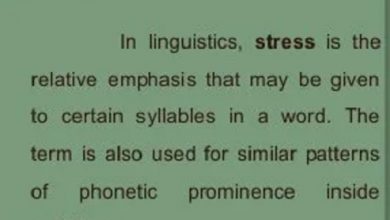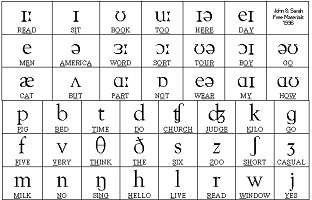Cardinal Vowels in English with list and description
Cardinal Vowels in English with list
Cardinal Vowels
The cardinal vowel is a system devised by the British pheneticist Daniel Jones in the early 20th century to classify, describe, and compare vowels of different languages and dialects around the world on the same basis. in this article, we will describe in detail the Cardinal Vowels in English with list
The basic vowel consists of eight primary vowels, eight secondary basic vowels, and two middle-high vowels [ɨ] and [ʉ]. The first basic vowels were set by dividing the vowels that humans can produce at the extremes of articulation phonetics and dividing them into equidistant distances by listening phonetics. And, in these vowels, the originality was changed to set the second basic vowel.
Among the primary basic vowels, the first vowel [i] that allows the lips to be stretched to both sides and the tongue to the highest and the front, and [i] that allows the tongue to be pulled out to the rear and the bottom in the state that the lips are neither round nor open. ɑ] was set. And, dividing the distance between [i] and [ɑ] by the acoustic equidistant distance, set [e], [ɛ], and [a] of the legendary vowel series, and [ɔ], [o], [u] of the Husserl vowel series. Was set.
The second basic vowel is the originality changed from the first basic vowel. Among the first basic vowels, the vowels obtained by rounding the lips with the tongue in the same position as when pronouncing the legendary series [i], [e], [ɛ], and [a] are [y], [ø], It is [œ], [ɶ]. Similarly, among the first basic vowels, the vowels obtained by pronouncing Husserl series [ɑ], [ɔ], [o], and [u] with only the lips open are [ɤ], [ɯ], [ʌ], and [ɒ].
Cardinal vowels, also basic vowels – a set of idealized vowels, pronounced at the extreme positions of the tongue in the mouth. While constructing the system, the auditory and articulation criteria were taken into account. The system of cardinal vowels was created mainly for educational purposes, in order to make it possible to easily classify sounds that do not form one logical sequence and elude simple generalizations, and to set reference points for the description of vowels regardless of the language
History (Cardinal Vowels in English with list)
The concept of cardinal vowels emerged as a result of the need to develop a system of vowels independent of any language, as the vowel system is much less intuitive to observe compared to the consonant system. In the first half of the 20th century, British pheneticist Daniel Jones devised a system he called ” cardinal vowels “. It was supposed to be simple to create (not exceed the student’s perception) and to navigate, and at the same time intuitive – the extreme positions should be easily perceptible. Jones was influenced at the time by the French linguist Paul Passy, so his vowel system was to some extent based on the Parisian pronunciation of French, used in educated spheres. For Jones, the graphic implementation of the diagram was also important, which he based on a trapeze.
Description of Cardinal Vowels
Nasal vowels
The cardinal vowel system uses only oral vowels. However, it is possible to give all 16 cardinal vowels a nasal value (so-called nasalization ), provided that the soft palate is lowered. It is difficult, however, to find such an abundantly translated language, although there are languages with a relatively large name
Diphthongs in the cardinal vowel system
It is not possible for the speech organs to be perfectly static during articulation, most often they are accompanied by some movement, for example when pronouncing the English word learn / lɜːn / in the Received Pronunciation standard; in some cases, such as diphthongs, the shift is even more obvious, such as for the word line / laɪn /. Pure vowels are marked with a dot that shows the highest position of the tongue, or with a circle because excessive precision in selecting vowels is inadequate for personal auditory sensations. The arrow then shows how the tongue moves to the end position
Vowel classification based on the cardinal vowel system
The ordering of vowels based on the system of cardinal vowels allows for their classification in terms of how they are pronounced. Based on the Jones diagram, the following criteria were introduced
oral cavity:
close vowels ( close )
semi-closed vowels ( mid-close, half-close )
half-open vowels ( mid-open, half-open )
vowel open ( open )
tongue sticking out:
front vowels ( front )
vowel central ( middle )
back vowels ( back )
Assessment of the cardinal vowel system
The cardinal vowel system has received many reviews, both positive and critical. The advantages of such a scale according to the English phoneticist Gimson are as follows
- the quality of the vowels does not depend on the value in individual languages
- the scale is fixed and standard
- allows you to produce any sound based on simple and unchanging principles.
One of the objections to the cardinal vowel system is that only / and/and / ɑ / is strictly defined in terms of articulation. The ratio of “equal acoustic distance” by Jones’s definition to equal articulation distance is not clearly defined. Jones determined the distances using X – rays of his own mouth, today it is known that these distances are very similar.
Another objection concerns the shape of the vowel trapezoid, which is not strictly defined and gives too much freedom of interpretation, based not only on the height of the tongue but also on the shape and position of the tongue in the mouth.
Moreover, it is noted that cardinal vowels are an artificial creation and for people unfamiliar with the rules of defining them, their pronunciation may sound exaggerated.
Cardinal Vowels in English with list
1 to 8 are main positioning vowels, and 9 to 16 are secondary positioning vowels. The lip positions of 1 to 8 are opposite to those of 9 to 16, for example, 1 corresponds to 9, and 2 corresponds to 10. The pronunciation positions of 1 to 16 are different in pairs before and after, for example, 1 corresponds to 8, 2 corresponds to 7. Add 17 and 18 two closed central vowels.
| cardinal | IPA | description |
| 1 | [I] | closed front unrounded vowel |
| 2 | [e] | near-middle front unrounded vowel |
| 3 | [ɛ] | open-middle front unrounded vowel |
| 4 | [and] | open front unrounded vowel |
| 5 | [ɑ] | open back unrounded vowel |
| 6 | [ɔ] | rounded vowel with an open mid-back |
| 7 | [o] | rounded back vowel |
| 8 | [u] | rounded vowel |
| 9 | [y] | rounded front vowel |
| 10 | [ø] | rounded front vowel |
| 11 | [ø] | open-middle front rounded vowel |
| 11 | [œ] | open-middle front rounded vowel |
| 12 | [ɶ] – | open front vowel with rounded corners |
| 13 | [ɒ] | open back rounded vowel |
| 14 | [ʌ] | open-middle back unrounded vowel |
| 15 | [ɤ] | near-middle back unrounded vowel |
| 16 | [ɯ] | closed unrounded vowel |
| 17 | [ɨ] | Closed center unrounded vowel |
| 18 | [ʉ] | close central rounded vowel |
Cardinal Vowels in English with list

